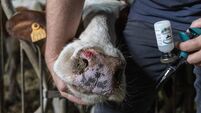Unease at Glanbia despite boom
They are, if you like, inactive members of the Co-op, but shareholders nonetheless. The A1 voting shareholders are the ones who are actively trading with the co-op
It’s a good year for Glanbia, with their share price advancing about 30% since March — and awards along the way, such as the Kerrygold Cup for cheese, shown here by the Glanbia Ballyragget Cheese Team, from left, Gerry Stuart, Vinny Cleere, Jim O’Neill (operations manager, Ballyragget), John Brennan, Breda Walsh, John Dunne (master cheese grader), John Phelan, Tom Lonergan (production manager), John Butler, Liz McDonough, Tim Purcell (cheese plant manager), James Daly, Ger Butler, Shane McDarby.













